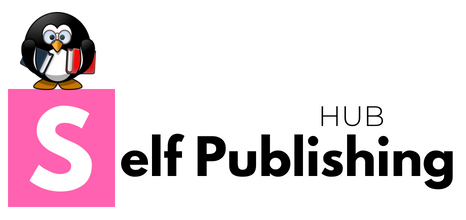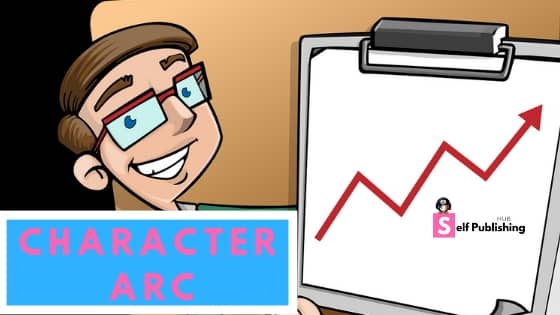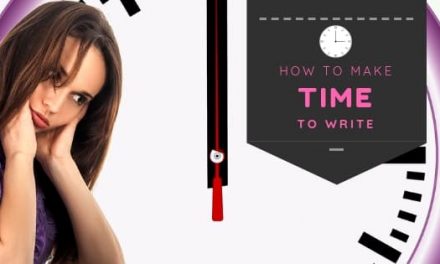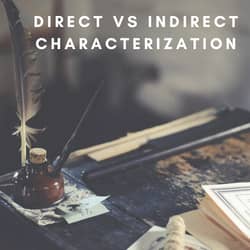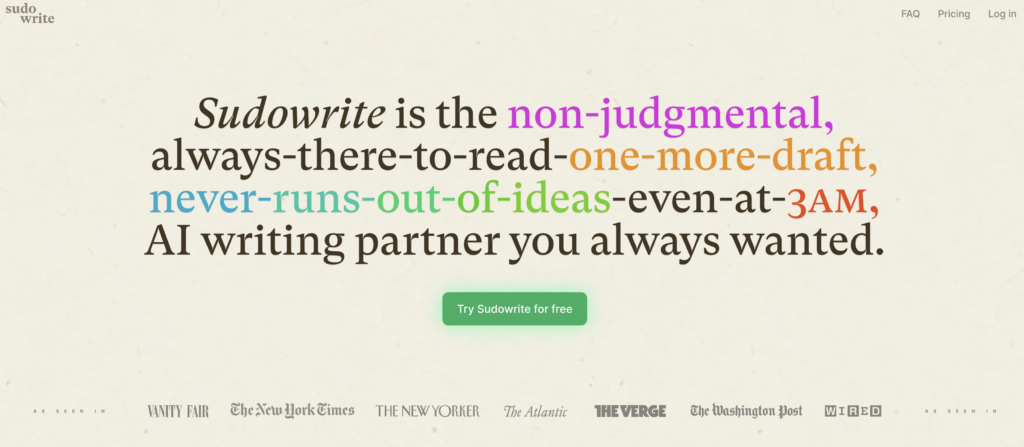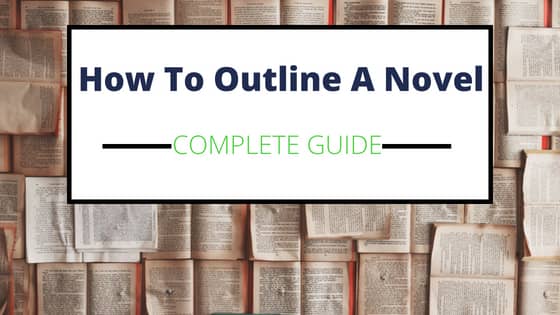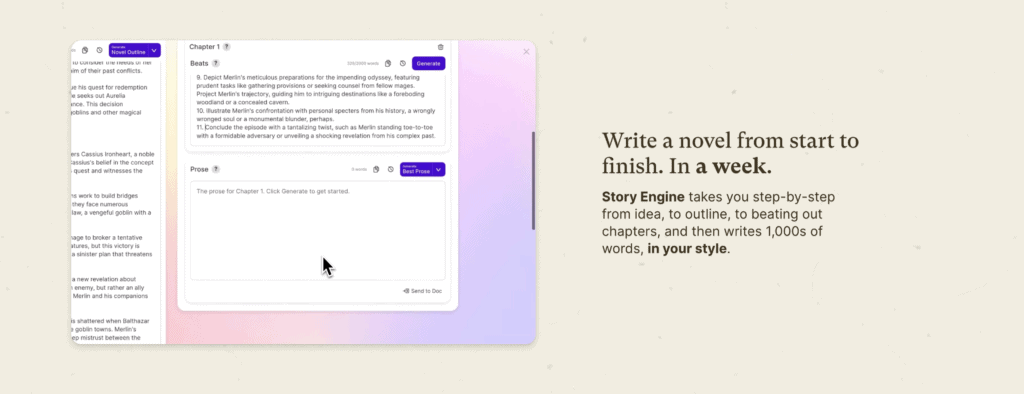Disclosure: The content on this site is free. Some of the links below are affiliate links from companies like Amazon.com and if you click the links and make a purchase we will receive a small commission at no additional cost to you. Thank you in advance if you decide to support our site by using our affiliate links!
We’ve laid out a complete guide to character development in a previous post but what we haven’t done up until this point, is dive deep into character arc. Character Arc can be one of those literary terms that everyone kind of knows intuitively, but it still manages to leave some lingering doubt in the heads of many writers. So in this article, we hope to demystify character arcs once and for all.
What is the definition of character arc? The character arc refers to the character’s inner growth throughout a story or series. This can sometimes be mischaracterized or oversimplified as a change, but while a character arc may include either positive or negative change, it is also possible for a character’s growth to happen with minimal change or even in their ability to show enough resolve not to change in the face of everything thrown at them.
In the remainder of this guide, we will dive deep into character arc in the hopes of:
- Explaining why Character Arc is so important
- Go into detail on the different types of character arcs
- Help you develop a great character arc every time
- Answer any lingering questions you may have about character arcs
- Provide you with examples of character arcs
To learn more about character arcs continue reading the rest of this guide.
Article Topics
Why is Character Arc So Important?
Most writers would agree that characters are the lifeblood of any story. Most of the time, without them, your setting, plot, and theme are impudent when it comes to their ability to impact the reader.
With that being said, most writers spend a lot of time in character development, as they should, but very little time when it comes to developing a character arc. Let’s look at why character arc is so important to the success of a good story.
Character arcs are the foundation of any great story as they provide the reader with an evolution of the character that will resonate at a humanistic core that is otherwise impossible with your story. To truly connect with your reader, they need to identify that inner journey your character is facing. It is on that joint emotional, intellectual, or spiritual journey that your readers will fall in love with your characters, and you as an author will earn the ability to leave them cheering, cringing, or crying.
The character arc is also important because it is closely intertwined with your stories theme. Some would go as far as saying that character arc and theme could be considered one in the same. The plot of your novel works to drive the story forward and should be in concert with your character’s arc and the story’s overall theme. Read these articles to get a better understanding of Theme and Plot.
Ultimately learning how to craft and incorporate a character arc into the fabric of your story will change them from good to great.
What are the Different Types of Character Arcs?
To help us identify and create character arcs, let’s take a look at the 3 different type of character arcs available to you as the writer. The 3 different types of character arcs are:
- The Change Arc
- The Negative Arc
- The Flat Arc
Let’s take a closer look at each of these types of arcs.
Character Arc #1: The Change Arc
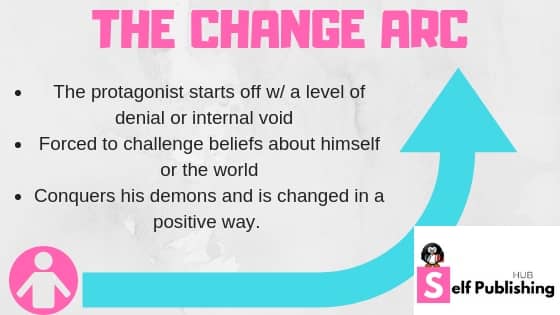
The first and most common character arc we will discuss is the Change Arc. The Change Arc is probably the most identifiable character arc for both writers and readers. The familiarity with this arcs helps it resonate at a high level.
- The Change Arc usually starts off with a character that suffers from varying degrees of inner turmoil, unfulfillment, or denial.
- The character may or may not be aware of this inner void at the beginning of the story.
- As they progress through the story, their view and personal beliefs of self or the world will be challenged.
- The arc forces the protagonist to face his inner demons
- In the end, the Change Arc leaves them changed in a positive way.
The Change character arc fits in perfectly with the typical Hero’s Journey Story Structure.
Character Arc #2: The Negative Arc
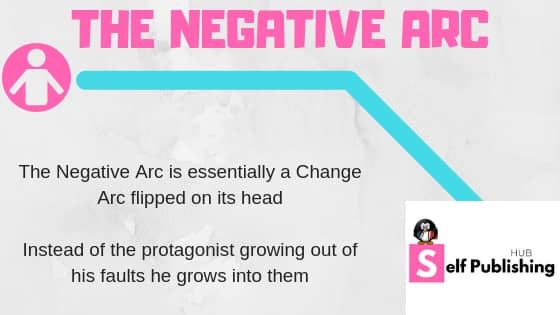
The next type of character arc that we will discuss is The Negative Arc. The Negative Arc is essentially a Change arc in reverse.
- Instead of the character growing into a better version or into positive traits throughout the story to end up in a better place at the end.
- With the Negative Arc, the character will diverge deeper into his/her faults throughout the story and end up in a worse place than where they started at the beginning of the story.
Character Arc #3: The Flat Arc
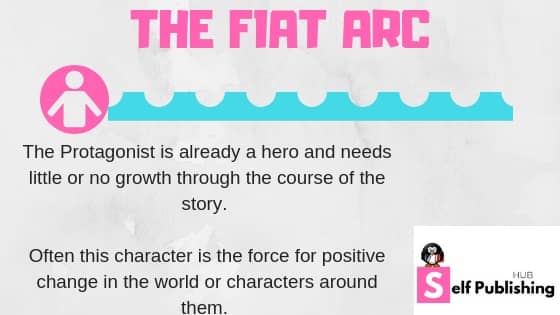
The third type of character arc is the Flat Arc. With the flat arc, the protagonist starts the story as a hero and requires very little growth throughout the story.
The protagonist often acts as a catalyst for change in the world or characters around them within a flat arc driven story. Usually, minor characters will go through more substantial character arcs in this scenario.
What makes a Good Character Arc?
Now that you know the 3 basic types of character arcs, let’s take a closer look at what makes a good character arc.
- A great character arc works in concert with the theme of your story. The theme of your story should express a universal concept that appeals to humanity at the most basic level. A good character arc should accentuate that theme through the growth of the character, or lack thereof.
- Your character arc needs to evolve organically through the events in the plot. Remember your story is being told for a specific reason, which means the plot events included should specifically support the theme and character arc of your protagonist’s story.
- It should resonate with the reader. As your character grows through their growth journey, the struggles and successes of that story should resonate with the reader. If your reader can envision themselves going through those inner challenges then they will be fully vested in the journey’s outcome.
- The best arcs hide in plain sight. Your character’s arc should not seem didactic or so evident that it becomes cliched, however, a well-executed arc takes the reader on the ride with it, and thus should never seem like the final outcome is a surprise or too convenient since they are interwoven into the fabric of the story.
- The internal arc should provide internal struggle which impedes then eventually supports the external struggle. This is ties back to the plot and character arc being closely interwoven. But make sure what holds your character back, whether they know it or not, is directly tied to that need or internal lacking.
- Establish how your character starts off to ensure how they end up pays off. The better you establish the character’s inner fault, lie, or lacking at the beginning of the character arc, the more vested a reader will be throughout the journey, and the more impactful the payoff will be.
How to Create a Great Character Arc in Story?
Arc Tip # 1: Think about and Develop Your Arc Early in the Process
This might sound a bit facetious, and it is, but really the mere fact that you are taking the time to develop your character arc prior to writing puts you ahead of a lot of writers. All too often we want to jump in and start writing, so we rush the preproduction work that is so necessary for writing.
I know right now there are two types of writers reading this, Plotters and Pantsers, and you are both rolling your eyes at me. The plotters are saying don’t tell me how important preproduction work is, while the Pantsers are thinking of wasting time on preproduction as pointless and there is no way they can create art like that.
I get both points of views, and honestly, I probably fall somewhere in-between the two. But the point is that a lot of times even when writers plot, or give themselves a rough outline of their story we neglect the character arc or give it cursory consideration.
So the first tip to creating a good character arc is one that you can start right now, and you kind have done already, give your character arc it’s deserved attention as you develop your story.
Arc Tip #2: Align Your Character Arc to the Story’s Thematic Concept and Statement
Earlier in the article, we said that the theme and character arc should be closely related. So make sure you understand yours prior to or in concert with your theme.
Have some lingering questions about Theme? No problem, we’ve got you covered, read our complete guide on mastering theme.
If you already understand Theme, then you know how central it is to other elements of your story. Your characters, plot, and setting should all help support your theme.
So your character arcs must also help support your theme. There should be a symbiosis between the two.
Example aligning your theme and character arc:
- Theme: If your Thematic Statement is “Power Eventually Corrupts all Men”
Then your character arc should develop that thematic statement.
- Meaning you could show a character that starts the story with the highest moral compass go through the Negative Change Arc as he gains more and more power until he loses his morality completely and becomes the embodiment of corruption.
Arc Tip # 3: Purposely Outline and Develop a Character Arc so it’s Aligned with your Story Structure and Plot
In this section, I thought it might be useful to give a construct of how you might design and structure your character arcs in your stories.
You should, of course, take these and make them your own, that is where your creative genius comes in. But I thought it might help you to see a skeleton of how you could carefully map out your character arc as methodically as your plot during pre-production to ensure it is developed throughout the story.
HOW TO WRITE THE POSITIVE CHANGE ARC
UNDERSTAND AND BUILD THE POSITIVE CHANGE CHARACTER ARC
- Understand What the Character is Lacking: This is an internal lacking, not external. Something that keeps the character unfulfilled or incomplete on the inside.
- Establish The Character’s Lie: This is a deeply held misconception about himself and/or the world. (As we said above, this lie will be a direct obstacle to achieving his external goals) It is a specific belief that you should be able to clearly articulate in one sentence, that the character themselves may or may not be aware of at first. Questions that can help identify the Lie:
- What ideas does the character have about himself or the world that are incorrect?
- What does this misconception keep him from having at an emotional level?
- How does the burden of this internal lie effect the character’s exterior world?
- Is the lie having a negative impact on his life when the story begins?
- If not, will the first plot point/inciting event begin to put stress on him due to the lie?
- What are the symptoms of the Lie
- Compare what Character Wants to What he Needs:
- What your character wants is usually always external in nature. It is typically an attempt to solve inner emptiness with exterior solutions. What the character wants is what drives the plot, it is the protagonist’s goal.
- What your character needs is truth to the lie. The truth or what the character needs may simply come in the form of a realization that his previous misconception about himself and/or the world were incorrect. Sometimes in that realization of truth, the character can obtain what he wants, or it in the truth, he may need to forgo what he wants in a bittersweet acceptance of what he needs.
- Questions to ask around needs vs wants:
- How is the lie holding the character back?
- How and Why is the lie making the character unhappy or empty?
- What truth does he need to disprove it?
- How will they learn the truth?
- What does he want more than anything else- Is it the plot goal?
- Does the character believe that the thing he wants will solve all inner personal problems?
- Does the thing he wants, hold him back from achieving what he needs? – or can he get them both?
- Questions to ask around needs vs wants:
- Know The Character’s Ghost or The Wound that Created the Lie
- The “Ghost” or wound that caused the lie. The bigger lie the character believes the bigger the wound should be. Think of as simple cause and effect. You need to decide how much of this Ghost or wound you will tell the reader and how you will do it. Will you divulge the full backstory early on, will parts of it come out over time? This is the anchor of your character’s lie, the reason he has been held hostage by it in the first place.
HOW TO ALIGN THE POSITIVE CHANGE ARC TO THE PLOT
- The Characteristic Moment Aligns to the Opening Scene/STORY HOOK: Your opening scene is so very important when it comes to hooking your readers. You need to make sure that you introducing your main protagonist and endearing him or at least making him interesting enough that your readers want to continue reading. In that scene, you want to accomplish a lot of things, introduce, describe, and give insight to the protagonists prevailing aspects of their personality. You also want to influence or at very least foreshadow later events while at demonstrating or giving a tiny hint to the character’s lie. Think of this as your chance to hook the reader and also frame your character arc.
- The Normal World Aligns to the First Act: This is the set-up of your story, it can also be thought of as the setting for your story in its normal state. Not only does this help set up the plot by giving context to what is going to happen in later parts of your story, but it also works to give context to your character arc. The Normal world should be symbolic of the character’s inner world. It also needs to dramatize the Lie that the character believes.
- 6 Parts of the Character Arc align to the First 25% of Your Book (Act I):
- Reinforcement of the lie
- Hint at the potential to overcome the lie
- Foreshadow how he’ll need to grow by giving hint to the nature of the lie
- Inciting Event which is initially refused
- Begin to Evolve the Character’s Perception of the Lie
- Character Makes a decision
- First Plot Point Aligns with putting your character on the path to destroying their lie. The decisions they make leading up to the first plot point, then the decisions they make decide what happens at the plot point, and the third decision they need to make is how they react to the plot point, all correlate with taking the character from the current world where they are complacent to their lie and puts them on a path to undoing their lie. This is where the first act ends and the second act starts.
- 4 Parts of the Character arc align with the first half of the second Act:
- Provide character with initial tools to overcome the lie
- Introduce new difficulties perpetuated by your character’s pursuit of the lie
- Move character closer to what he wants and further from what he needs
- A glimpse of Life without the lie
- The Midpoint Aligns with the character turning away from the effects of the lie: In the midpoint, the character has his Moment of Grace in which he sees the truth, at this point, he is still not ready to reject the lie but sees merit in the opposing viewpoint. This is part of a subtle evolution of the character.
- 6 Parts of the Character Arc that align with the Second Half of the Second Act:
- The character acts in ways that weren’t possible until his new enlightened state
- The character gets trapped between the old lie and new truth
- A character attempts to escape the effects of the lie
- The contrast of before and after ways of thinking
- The False Big Win
- Give your character an outward validation of the truth
- The 3rd Plot Point Aligns with the character’s need stop deceiving himself about the lie. While the 3rd plot point is the character’s low point in the plot where his plot goals are endangered. The 3rd plot point accomplishes the following in terms of character arc:
- The final choice between want and need
- The old self-dies forever
- 4 Parts of the Character Arc coincide with the Third Act
- The Stakes are increased
- The character is off balance – Claimed the truth but hasn’t 100% rejected the lie
- Proof of how far he’s come
- Another attack on the character’s new paradigm
- The Final Rejection of the Lie aligns with the Climax: This can happen during the climax if the character’s internal struggle is closely related to the plot, or prior to the climax, leading to the final climactic victory.
- The Resolution aligns to the characters the new world has been shaped by the character’s shedding of his previous lie and embrace of the truth.
- It answers the thematic question which in essence was a battle between your character’s lie and truth
- Back up the readers understanding of your character’s change with a visual representation of the new world.
How to Write The Flat a Flat Character Arc and Align it to Story Structure
If the Change Arc is all about the character’s lie, the flat character arc is all about the character’s truth. With a flat character arc, your character already understands the truth. During the story, the truth will be tested as will his resolve to stay true to it.
- The Normal World: Either set up representing the positivity of the truth that must be protected or a world that has been decimated by the lie which needs to be overcome
- The Characteristic Moment: Works the same as in the Change Arc, but the reader must be introduced to the Truth and not the lie of the character
- The First Act: Spend time aligning the characters to which side of the truth and lie they fall on. The character may spend the first act unaware of the lie or it’s consequences or trying to avoid confronting the lie.
- The First Half of Second Act: Similar to that of change arc, but your character will spend the first half of second act getting punished or enduring hardship for believing the truth.
- The Midpoint: The important revelation is when the protagonist sees just how big the lie is and what the consequences of the antagonist’s motives would be. The Moment of Grace shows the protagonist’s new resolve.
- The Second Half of the Second Act: The protagonist goes from reactive to proactive and is determined to exploit whatever weakness he has spotted in the lie.
- The first half of the Third Act: Character reacting to the third-plot point. Supporting characters are fully embracing the truth. He reaffirms his commitment to the cause.
- The Climax: The protagonist will face the antagonist and pit his truth vs the lie. The difference from the Change arc is that the character already fully believes the truth in the flat arc.
- The Resolution: The truth is now evident in the supporting characters and world around the protagonist.
How to Write a Negative Character Arc and Align it to Plot
Remember the Negative Change Arc tells a story of a character that ends up in a worse place than where he started.
There are 3 types of Negative Character Arcs:
- The Disillusionment Arc: Character Believes Lie then Overcomes Lies, but the New Truth is Tragic
- The Fall Arc: Character Believes Lie-Holds onto lie despite all – Rejects all forms of the truth- and believes even worse forms of the lie
- The Corruption Arc: Character sees the truth, rejects truth, and embraces the Lie
Depending on which negative arc you choose, you will want to craft each of your story points accordingly.
If you want more detail on how this would look at each point in the story read K.M. Weiland Blog here.
She also has two great books that I would highly recommend to help you outline and structure your novels. Very aptly named below:
Examples of Character Arcs
We’ve covered a lot about creating character arcs, but in an effort to take this concept from theory to practical examples, let’s take a look at 10 examples of great character arcs in Film.
- The Change Arc: Hero’s Journey – Kikuchiyo from Seven Samurai It is a pitting of pridefulness versus self-sacrifice, of noble dreams versus their difficult realities, all set against the backdrop of a peasant’s orphan past.
- The Change Arc: Moral Growth – Jules from Pulp Fiction Pulp Fiction does a wonderful job of walking us quietly through his revelation-by-parts on the way to becoming a righteous man.
- The Change Arc: Reluctant Hero – Rick Blaine from Casablanca A broken heart made him shun heroism, but it takes the same woman who broke his heart to soften it, and we get to watch gleefully as he reveals himself to be the hero he tried so hard not to.
- Let’s Go/Becomes Free – Bobby Dupea from Five Easy Pieces We’re not quite sure where he’s going. Or how specifically he’s changed. But he’s reached his breaking point and decided to leave it all behind. Whatever life he had before, he’s given it up now and is no longer the same person for it.
- Change Arc: Grow Together – The Entire Cast from Boyhood For all the emotional growth an actor can do on screen in a typical 3-month span, there’s nothing like actual time to really kick it up a notch.
- The Flat Arc: Failure to Change – Alex from A Clockwork Orange While the entire plot is focused on getting this violent criminal to change his ways, in the end, he ends up exactly where he started
- The Change Arc: Confronting Death – Dr. Isak Borg from Wild Strawberries It is the psychological journey of a man and his self-reckoning in his final act. Beginning in a place of guilt and resolving itself in some small amount of solace and acceptance.
- The Negative Arc/ Corruption Arc: Rise to Power – Michael Corleone from The Godfather From saintly war-hero to a family leader of quiet cruelty, it is the slow, seductive corruption of a moral man.
- The Negative Arc/The Fall Arc: Descent into Madness – Mabel from A Woman Under the Influence, In the beginning, Mabel is perhaps just a little strange but what follows is one of the most brilliantly acted unravellings in the history of cinema.
- The Negative Arc/Disillusionment Arc: Rise and Fall – Citizen Kane from Citizen Kane A monument to an American Icarus, flying too high and lending proof to Fitzgerald’s claim that “there are no second acts in American lives.”
Do All Stories Need to Feature Prominent Arcs?
Character arcs are important in every story, but their prominence in the story may depend on the genre you are writing in.
Some stories are more plot dependent and less character arc dependent. With that being said, if you can still consider your character’s arc when crafting your story outline, you will end up with more well-rounded and compelling characters.
It is true that some genres like mystery or action are more plot-driven, while certain genres are more character focused, an example of this would be Romance.
Remember that sometimes a character might not seem to change, but make sure you aren’t just witnessing a flat arc, if the story shows the steadfast character solidifying resolve of character in the face of opposition then that is still a type of character arc.
So the question should really be how central is character arc to your story.
Other Great Resources on Developing Character Arc
